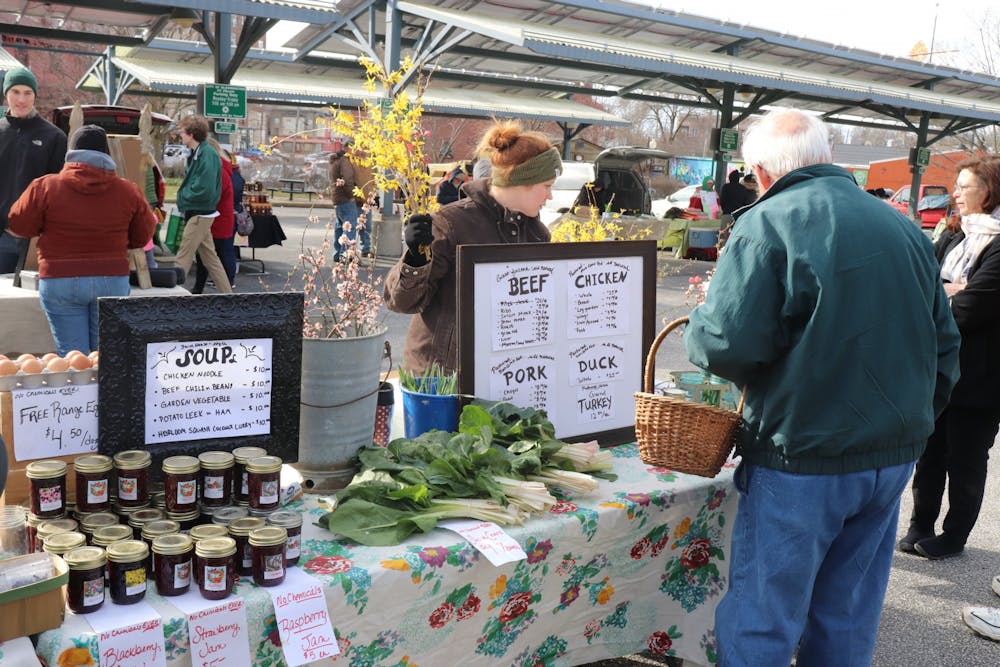At the beginning of the year, I decided I was going to try to eat out less and eat more fresh produce. My commitment to that goal has shifted on and off as this extremely stressful semester has progressed. Late nights and a sole focus on the mountain of work ahead often means takeout — not a homemade meal.
Now that the spring semester is almost over, I am revisiting my commitment to eating fresh. I’m also adding a new criteria: to eat locally.
Eating local and fresh has the benefit of keeping money in the community and fostering connection to food and its production. Eating local food is also more environmentally sustainable. Local food travels fewer miles and decreases greenhouse gas emissions than nationally or internationally-sourced items.
Bloomington has a variety of local agricultural options — from produce to meats to specialty products — that make it easy for students to practice eating fresh locally.
I am going to invest in local agriculture this summer. Here is how and why you should too.
Farmers markets offer a commitment-free way to explore local agriculture and fresh eating.
The Bloomington Community Farmers’ Market opened for the 2021 season on April 3. The market runs every week Saturday 8 a.m. to 1 p.m. and Tuesday 4 p.m. to 7 p.m. There are COVID-19 safety guidelines for visitors, as well as directories for available vendors and produce at the market on the Bloomington government website.
While the Bloomington Community Farmers’ Market is likely the most well known farmers market in the area, there are other options to choose from such as the Woolery Farmers’ Market — operating on Saturday mornings — and the Smithville Farmers’ Market, which begins in May.
Both the Bloomington and Woolery farmers’ markets accept Supplemental Nutrition Assistance Program benefits. Trying to eat fresh or local is often thought to be more expensive. However with SNAP benefits, farmers markets become more accessible to lower income eaters.
If you want an opportunity to support local farms and agriculture more directly and with more commitment, community-supported agriculture, known as CSA, offers another option. CSAs allow consumers to pay upfront costs in exchange for products on a weekly, biweekly or monthly basis.
Compared to Kroger or other grocery chains, CSA membership puts more power into the local community and fosters a better connection with the food community members eat. With CSAs, the food is all local and seasonal.
In the Bloomington area, farms such as Sobremesa Farm are currently open to CSA members for a cycle starting July 8 and ending Aug. 26 at $160 for a full share or $80 for a half share. Schacht Farm, a livestock-based CSA, is accepting applications for the summer cycle until May 15 and charges $385 to $475.
Maple Valley Farm offers a similar CSA to Schacht Farm but yearlong. Living Roots is still accepting members for the main season starting mid-May and ending in October.
Many CSAs, such as Sobremesa Farm, are fully organic. Sobremesa Farm also uses a permaculture and regenerative agriculture approach to its farming, which means it’s better for the environment. Buying into a CSA gives consumers more say in what they eat as well as how it’s produced.
Obviously, this option is for people who have the funds and know their food budget. While these shares are a more expensive option upfront, they guarantee season long access to fresh produce.
Due to financial reasons, I will probably start off wandering through the Bloomington Community Farmers’ Market and then upgrade to a CSA later, if I can.
There is also the Bloomingfoods Co-Op Market, which was founded in 1975 and has a history in Bloomington of providing local food to Bloomington residents. Bloomingfoods is partnered with more than 90 local producers and also has a SNAP benefits program. Bloomingfoods, as a co-op, also allows consumers to become “owner-members” in the grocery store, which allows them to pay a one-time membership fee in exchange for reduced cost and involvement on its board.
There are many opportunities for Bloomington residents to get involved in local agriculture and eating fresh.
During the COVID-19 pandemic, the responsibility to buy local is even more apparent — COVID-19 had profound effects on the global economy and food security. Local food consumption and production mitigates the risk of food insecurity to our community.
For my townies, the opportunity to participate in Bloomington’s local food scene is just starting. However, for students moving back home for the summer or for those who stayed home because of the pandemic, I would encourage you to look into what your community has to offer.
Eating local isn’t just a choice, it’s a vital change we have to make.
Evan Shaw (he/they) is a sophomore studying journalism. He also minors in Arabic and Spanish and hopes to one day become a polyglot.






